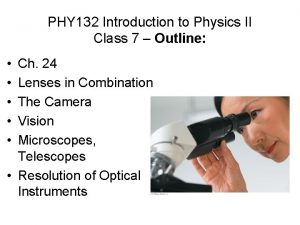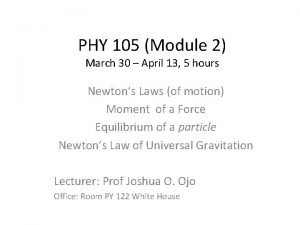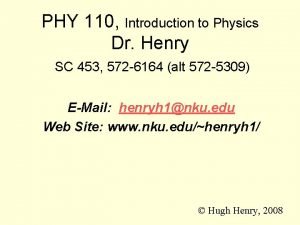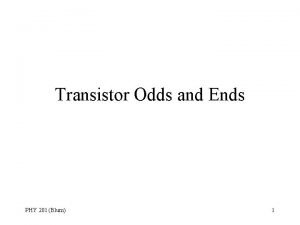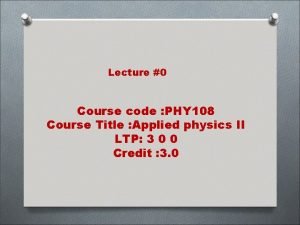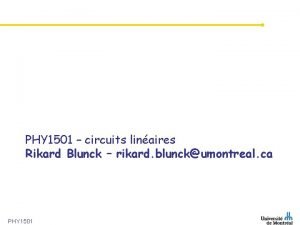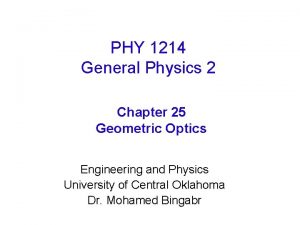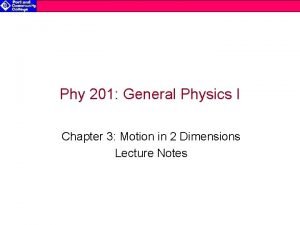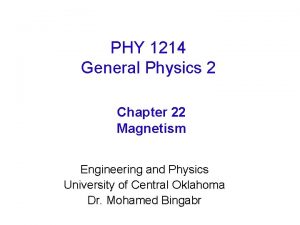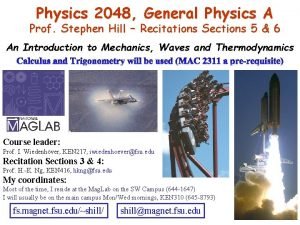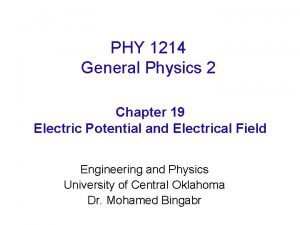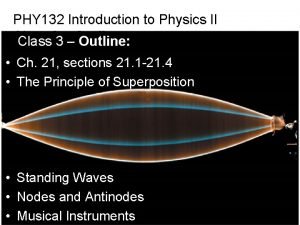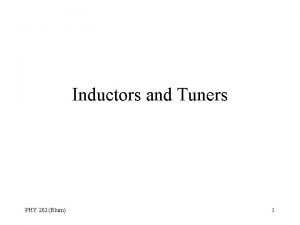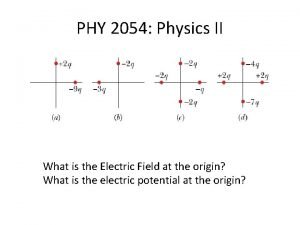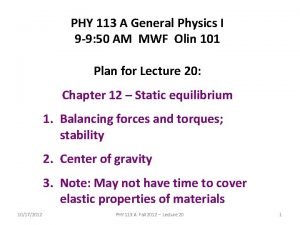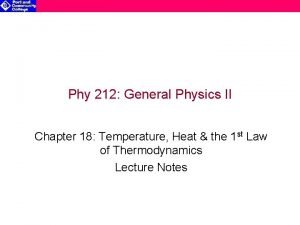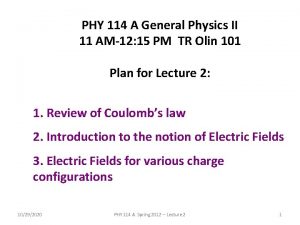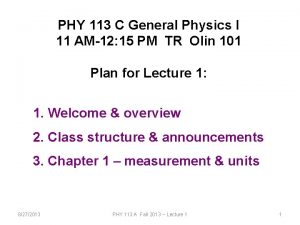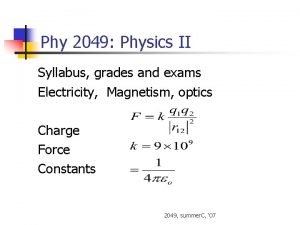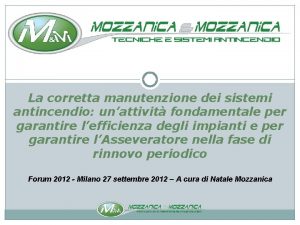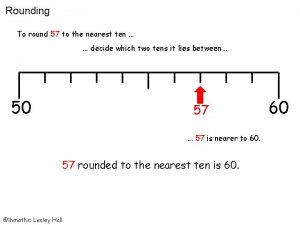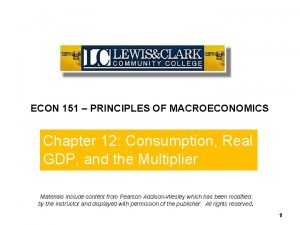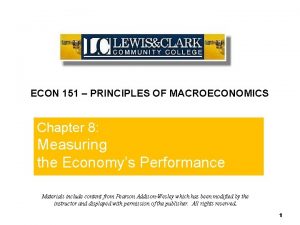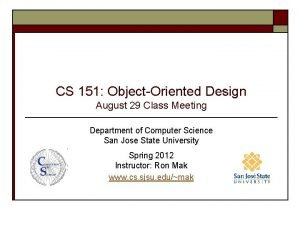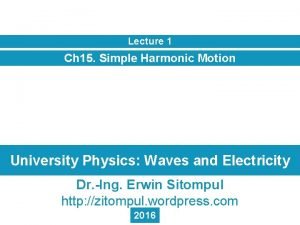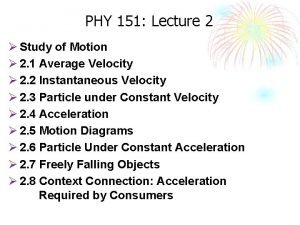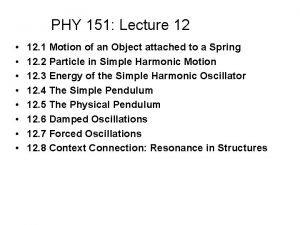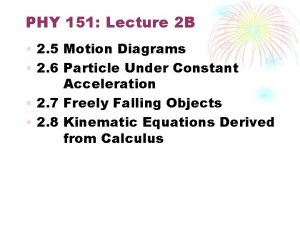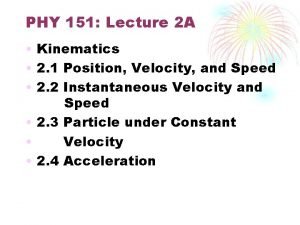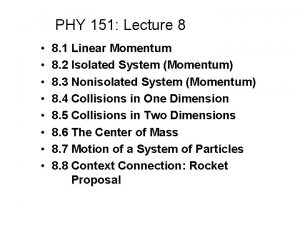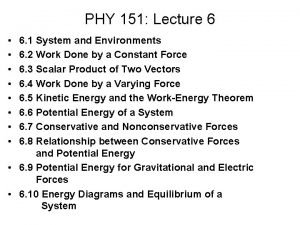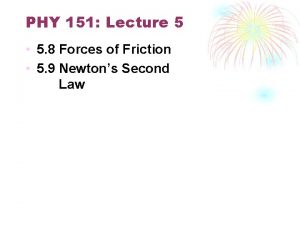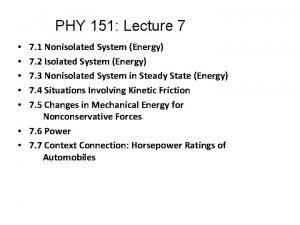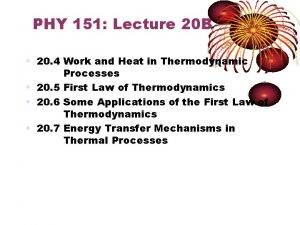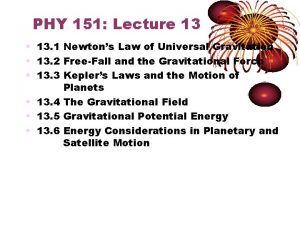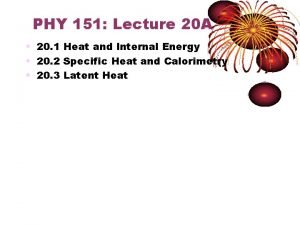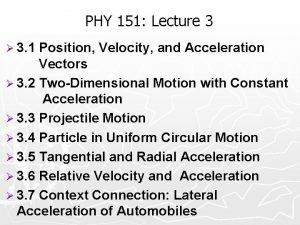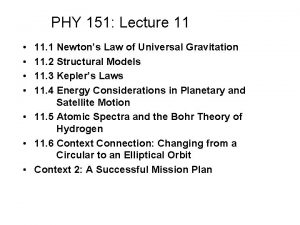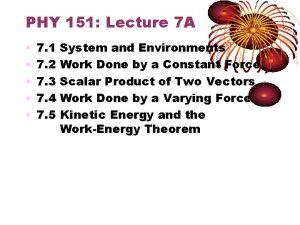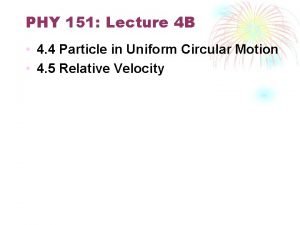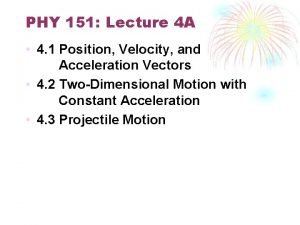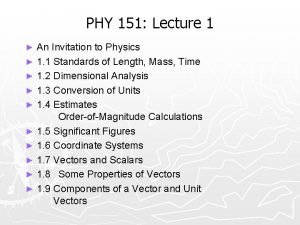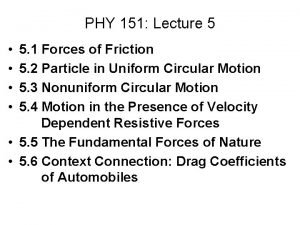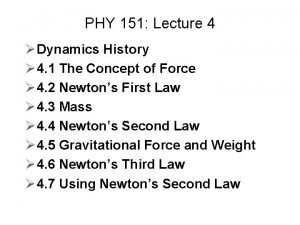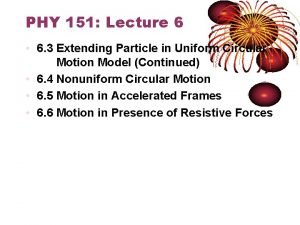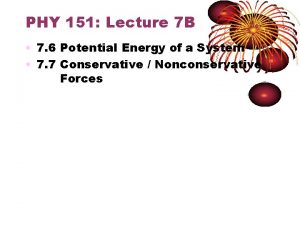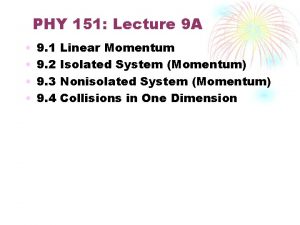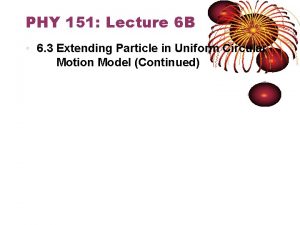PHY 151 Lecture 15 15 1 Motion of
































































- Slides: 64

PHY 151: Lecture 15 • 15. 1 Motion of an Object attached to a Spring • 15. 2 Particle in Simple Harmonic Motion • 15. 3 Energy of the Simple Harmonic Oscillator • 15. 4 Comparing Simple Harmonic Motion with Uniform Circular Motion • 15. 5 The Pendulum • 15. 6 Damped Oscillations • 15. 7 Forced Oscillations

PHY 151: Lecture 15 Oscillatory Motion 15. 1 Motion of an Object Attached to a Spring

Oscillations and Mechanical Waves • Periodic motion is the repeating motion of an object in which it continues to return to a given position after a fixed time interval • The repetitive movements are called oscillations • A special case of periodic motion called simple harmonic motion will be the focus – Simple harmonic motion also forms the basis for understanding mechanical waves • Oscillations and waves also explain many other phenomena quantity – Oscillations of bridges and skyscrapers – Radio and television – Understanding atomic theory

Periodic Motion • Periodic motion is motion of an object that regularly returns to a given position after a fixed time interval • A special kind of periodic motion occurs in mechanical systems when the force acting on the object is proportional to the position of the object relative to some equilibrium position – If the force is always directed toward the equilibrium position, the motion is called simple harmonic motion

Motion of a Spring-Mass System • A block of mass m is attached to a spring, the block is free to move on a frictionless horizontal surface • When the spring is neither stretched nor compressed, the block is at the equilibrium position Øx = 0 • Such a system will oscillate back and forth if disturbed from its equilibrium position

Hooke’s Law • Hooke’s Law states Fs = - kx – Fs is the restoring force • It is always directed toward the equilibrium position • Therefore, it is always opposite the displacement from equilibrium Øk is the force (spring) constant Øx is the displacement

Restoring Force and the Spring Mass System • In a, the block is displaced to the right of x=0 – The position is positive – The restoring force is directed to the left • In b, block is at equilibrium position x = 0 – The spring is neither stretched nor compressed – The force is 0

Restoring Force, cont. • The block is displaced to the left of x = 0 – The position is negative – The restoring force is directed to the right

Acceleration • When the block is displaced from the equilibrium point and released, it is a particle under a net force and therefore has an acceleration • The force described by Hooke’s Law is the net force in Newton’s Second Law • The acceleration is proportional to the displacement of the block • The direction of the acceleration is opposite the direction of the displacement from equilibrium • An object moves with simple harmonic motion whenever its acceleration is proportional to its position and is oppositely directed to the displacement from equilibrium

Acceleration, cont. • The acceleration is not constant – Therefore, the kinematic equations cannot be applied – If the block is released from some position x = A, then the initial acceleration is –k. A/m – When the block passes through the equilibrium position, a = 0 – The block continues to x = -A where its acceleration is +k. A/m

Motion of the Block • The block continues to oscillate between –A and +A – These are turning points of the motion • The force is conservative • In the absence of friction, the motion will continue forever – Real systems are generally subject to friction, so they do not actually oscillate forever

PHY 151: Lecture 15 Oscillatory Motion 15. 2 Particle in Simple Harmonic Motion

A Particle in Simple Harmonic Motion • Model the block as a particle – The representation will be particle in simple harmonic motion model • Choose x as the axis along which the oscillation occurs • Acceleration • We let • Then a = -w 2 x

A Particle in Simple Harmonic Motion, 2 • A function that satisfies the equation is needed – Need a function x(t) whose second derivative is the same as the original function with a negative sign and multiplied by w 2 – The sine and cosine functions meet these requirements

Simple Harmonic Motion – Graphical Representation • A solution is x(t) = A cos (w t + f) • A, w, f are all constants • A cosine curve can be used to give physical significance to these constants

Simple Harmonic Motion – Definitions • A is the amplitude of the motion – This is the maximum position of the particle in either the positive or negative x direction • w is called the angular frequency – Units are rad/s – • f is the phase constant or the initial phase angle

Simple Harmonic Motion, cont. • A and f are determined uniquely by the position and velocity of the particle at t = 0 • If the particle is at x = A at t = 0, then f = 0 • The phase of the motion is the quantity (wt + f) • x(t) is periodic and its value is the same each time wt increases by 2 p radians

Period • The period, T, of the motion is the time interval required for the particle to go through one full cycle of its motion – The values of x and v for the particle at time t equal the values of x and v at t + T

Frequency • The inverse of the period is called the frequency • The frequency represents the number of oscillations that the particle undergoes per unit time interval • Units are cycles per second = hertz (Hz)

Summary Equations – Period and Frequency • The frequency and period equations can be rewritten to solve for w • The period and frequency can also be expressed as: • The frequency and the period depend only on the mass of the particle and the force constant of the spring • They do not depend on the parameters of motion • The frequency is larger for a stiffer spring (large values of k) and decreases with increasing mass of the particle

Motion Equations for Simple Harmonic Motion • Simple harmonic motion is one-dimensional and so directions can be denoted by + or - sign • Remember, simple harmonic motion is not uniformly accelerated motion

Maximum Values of v and a • Because the sine and cosine functions oscillate between ± 1, we can easily find the maximum values of velocity and acceleration for an object in SHM

Graphs • The graphs show: – (a) displacement as a function of time – (b) velocity as a function of time – (c ) acceleration as a function of time • The velocity is 90 o out of phase with the displacement and the acceleration is 180 o out of phase with the displacement

SHM Example 1 • Initial conditions at t = 0 are Ø x (0)= A Ø v (0) = 0 • This means f = 0 • The acceleration reaches extremes of ± w 2 A at ±A • The velocity reaches extremes of ± w. A at x = 0

SHM Example 2 • Initial conditions at t = 0 are – x (0)=0 – v (0) = vi • This means f = - p / 2 • The graph is shifted one-quarter cycle to the right compared to the graph of x (0) = A

PHY 151: Lecture 15 Oscillatory Motion 15. 3 Energy of the Simple Harmonic Oscillator

Energy of the SHM Oscillator • Mechanical energy is associated with a system in which a particle undergoes simple harmonic motion – For example, assume a spring-mass system is moving on a frictionless surface • Because the surface is frictionless, the system is isolated – This tells us the total energy is constant • The kinetic energy can be found by Ø K = ½ mv 2 = ½ mw 2 A 2 sin 2 (wt + f) • Assume a massless spring, so the mass is the mass of the block • The elastic potential energy can be found by Ø U = ½ kx 2 = ½ k. A 2 cos 2 (wt + f) • • Because w 2 = k/m The total energy is E = K + U = ½ k. A 2[sin 2(wt + f) + cos 2(wt + f)] E = ½ k. A 2

Energy of the SHM Oscillator, cont. • The total mechanical energy is constant – At all times, the total energy is – ½ k. A 2 • The total mechanical energy is proportional to the square of the amplitude • Energy is continuously being transferred between potential energy stored in the spring and the kinetic energy of the block • In the diagram, Φ = 0

Energy of the SHM Oscillator, final • Variations of K and U can also be observed with respect to position. • The energy is continually being transformed between potential energy stored in the spring and the kinetic energy of the block • The total energy remains the same

Energy in SHM, summary

Velocity at a Given Position • Energy can be used to find the velocity:

Importance of Simple Harmonic Oscillators • Simple harmonic oscillators are good models of a wide variety of physical phenomena • Molecular example – If the atoms in the molecule do not move too far, the forces between them can be modeled as if there were springs between the atoms – The potential energy acts similar to that of the SHM oscillator

PHY 151: Lecture 15 Oscillatory Motion 15. 4 Comparing Simple Harmonic Motion with Uniform Circular Motion

SHM and Circular Motion • This is an overhead view of an experimental arrangement that shows the relationship between SHM and circular motion • As the turntable rotates with constant angular speed, the ball’s shadow moves back and forth in simple harmonic motion

SHM and Circular Motion, 2 • The circle is called a reference circle – For comparing simple harmonic motion and uniform circular motion • Take P at t = 0 as the reference position • Line OP makes an angle f with the x axis at t = 0

SHM and Circular Motion, 3 • The particle moves along the circle with constant angular velocity w • OP makes an angle q with the x axis. • At some time, the angle between OP and the x axis will be q = wt + f • The points P and Q always have the same x coordinate. • x (t) = A cos (wt + f) • This shows that point Q moves with simple harmonic motion along the x axis

SHM and Circular Motion, 4 • The angular speed of P is the same as the angular frequency of simple harmonic motion along the x axis • Point Q has the same velocity as the x component of point P • The x-component of the velocity is • v = -w A sin (w t + f)

SHM and Circular Motion, 5 • The acceleration of point P on the reference circle is directed radially inward • P ’s acceleration is a = w 2 A • The x component is • –w 2 A cos (wt + f) • This is also the acceleration of point Q along the x axis.

PHY 151: Lecture 15 Oscillatory Motion 15. 5 The Pendulum

Simple Pendulum • A simple pendulum also exhibits periodic motion • It consists of a particle-like bob of mass m suspended by a light string of length L • The motion occurs in the vertical plane and is driven by gravitational force • The motion is very close to that of the SHM oscillator – If the angle is <10 o

Simple Pendulum, 2 • The forces acting on the bob are the tension and the weight – is the force exerted on the bob by the string – is the gravitational force • The tangential component of the gravitational force is a restoring force

Simple Pendulum, 3 • In the tangential direction, • The length, L, of the pendulum is constant, and for small values of q • This confirms the mathematical form of the motion is the same as for SHM

Simple Pendulum, 4 • The function q can be written as q = qmax cos (wt + f) • The angular frequency is • The period is

Simple Pendulum, Summary • The period and frequency of a simple pendulum depend only on the length of the string and the acceleration due to gravity • The period is independent of the mass • All simple pendula that are of equal length and are at the same location oscillate with the same period

Physical Pendulum, 1 • If a hanging object oscillates about a fixed axis that does not pass through the center of mass and the object cannot be approximated as a point mass, the system is called a physical pendulum – It cannot be treated as a simple pendulum • The gravitational force provides a torque about an axis through O. • The magnitude of the torque is • mgdsin q

Physical Pendulum, 2 • I is the moment of inertia about the axis through O • From Newton’s Second Law, • The gravitational force produces a restoring force • Assuming q is small, this becomes

Physical Pendulum, 3 • This equation is of the same mathematical form as an object in simple harmonic motion • The solution is that of the simple harmonic oscillator • The angular frequency is • The period is

Physical Pendulum, 4 • A physical pendulum can be used to measure the moment of inertia of a flat rigid object – If you know d, you can find I by measuring the period • If I = md 2 then the physical pendulum is the same as a simple pendulum – The mass is all concentrated at the center of mass

Torsional Pendulum • Assume a rigid object is suspended from a wire attached at its top to a fixed support • The twisted wire exerts a restoring torque on the object that is proportional to its angular position

Torsional Pendulum • Assume a rigid object is suspended from a wire attached at its top to a fixed support • The twisted wire exerts a restoring torque on the object that is proportional to its angular position • The restoring torque is t = -kq – k is the torsion constant of the support wire • Newton’s Second Law gives

Torsional Period, cont. • The torque equation produces a motion equation for simple harmonic motion • The angular frequency is • The period is – No small-angle restriction is necessary – Assumes the elastic limit of the wire is not exceeded

PHY 151: Lecture 15 Oscillatory Motion 15. 6 Damped Oscillations

Damped Oscillations • In many real systems, non-conservative forces are present – This is no longer an ideal system (the type we have dealt with so far) – Friction and air resistance are common nonconservative forces • In this case, the mechanical energy of the system diminishes in time, the motion is said to be damped

Damped Oscillation, Example • One example of damped motion occurs when an object is attached to a spring and submerged in a viscous liquid • The retarding force can be expressed as – b is a constant – b is called the damping coefficient

Damped Oscillations, Graph • A graph for a damped oscillation • The amplitude decreases with time • The blue dashed lines represent the envelope of the motion • Use the active figure to vary the mass and the damping constant and observe the effect on the damped motion • The restoring force is – kx

Damped Oscillations, Equations • From Newton’s Second Law • SFx = -kx – bvx = max • When the retarding force is small compared to the maximum restoring force we can determine the expression for x – This occurs when b is small • The position can be described by • The angular frequency will be

Damped Oscillations, Natural Frequency • When the retarding force is small, the oscillatory character of the motion is preserved, but the amplitude decreases exponentially with time • The motion ultimately ceases • Another form for the angular frequency: • – where w 0 is the angular frequency in the absence of the retarding force and is called the natural frequency of the system. –

Types of Damping • If the restoring force is such that b/2 m < wo, the system is said to be underdamped • When b reaches a critical value bc such that bc / 2 m = w 0, the system will not oscillate – The system is said to be critically damped • If the restoring force is such that b/2 m > wo, the system is said to be overdamped

Types of Damping, cont • Graphs of position versus time for – An underdamped oscillator – blue – A critically damped oscillator – red – An overdamped oscillator – black • For critically damped and overdamped there is no angular frequency

PHY 151: Lecture 15 Oscillatory Motion 15. 7 Forced Oscillations

Forced Oscillations • It is possible to compensate for the loss of energy in a damped system by applying a periodic external force. • The amplitude of the motion remains constant if the energy input per cycle exactly equals the decrease in mechanical energy in each cycle that results from resistive forces. • After a driving force on an initially stationary object begins to act, the amplitude of the oscillation will increase • After a sufficiently long period of time, Edriving = Elost to internal – Then a steady-state condition is reached – The oscillations will proceed with constant amplitude

Forced Oscillations, cont. • The amplitude of a driven oscillation is – w 0 is the natural frequency of the undamped oscillator.

Resonance • When the frequency of the driving force is near the natural frequency (w » w 0) an increase in amplitude occurs • This dramatic increase in the amplitude is called resonance • The natural frequency w 0 is also called the resonance frequency of the system • At resonance, the applied force is in phase with the velocity and the power transferred to the oscillator is a maximum – The applied force and v are both proportional to sin (wt + f) – The power delivered is • This is a maximum when the force and velocity are in phase. • The power transferred to the oscillator is a maximum.

Resonance, cont. • Resonance (maximum peak) occurs when driving frequency equals the natural frequency • The amplitude increases with decreased damping • The curve broadens as the damping increases • The shape of the resonance curve depends on b
 Transopia
Transopia 01:640:244 lecture notes - lecture 15: plat, idah, farad
01:640:244 lecture notes - lecture 15: plat, idah, farad Phy-105 5 discussion
Phy-105 5 discussion Phy 205
Phy 205 General physics measurement
General physics measurement Law of motion
Law of motion Phy 231 msu
Phy 231 msu Phy
Phy Phy
Phy Phy108
Phy108 Phy113
Phy113 Rikard blunck
Rikard blunck Real image
Real image Eyephy
Eyephy Phy 1214
Phy 1214 Complete motion diagram
Complete motion diagram The great orthogonality theorem
The great orthogonality theorem Atm packet phy
Atm packet phy Phy tgen
Phy tgen Applications of magnetism
Applications of magnetism Phy 131 asu
Phy 131 asu Stephen hill fsu
Stephen hill fsu Phy 1214
Phy 1214 Phy 132
Phy 132 Phy 2049
Phy 2049 Phy
Phy Rotational statics
Rotational statics Phy
Phy 2012 phy
2012 phy Ddr phy architecture
Ddr phy architecture Examples of convection
Examples of convection Phy
Phy Phy 131 past papers
Phy 131 past papers Phy
Phy Phy 1214
Phy 1214 Phy theorem
Phy theorem Life phy
Life phy Phy 2049
Phy 2049 Dpr 151/2011
Dpr 151/2011 A software consists of
A software consists of Tổng kết vốn từ 151
Tổng kết vốn từ 151 Sucrose solubility curve
Sucrose solubility curve Main event management
Main event management Econ 151
Econ 151 118/151
118/151 Item 151
Item 151 Mcb 101 uiuc
Mcb 101 uiuc Hino 151
Hino 151 Sjsu cs 151
Sjsu cs 151 Aphra rogers
Aphra rogers Round off 51 to the nearest 10
Round off 51 to the nearest 10 The equilibrium level of real gdp
The equilibrium level of real gdp Econ 151
Econ 151 Uci computer science specialization
Uci computer science specialization Cs 151 sjsu
Cs 151 sjsu 1,151,725 bytes
1,151,725 bytes Chm 151 final exam
Chm 151 final exam What is angular frequency in shm
What is angular frequency in shm Simple harmonic motion lecture
Simple harmonic motion lecture Describing and measuring motion
Describing and measuring motion Harmonic equation physics
Harmonic equation physics Chapter 2 motion section 1 describing motion answer key
Chapter 2 motion section 1 describing motion answer key An object in motion stays in motion
An object in motion stays in motion Section 1 describing motion answer key
Section 1 describing motion answer key Type of range of motion
Type of range of motion
